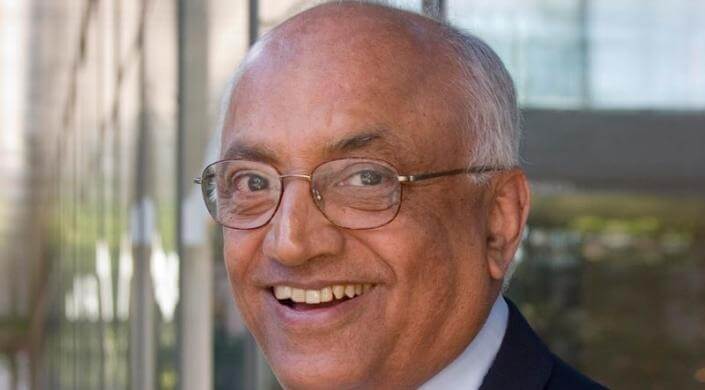News
Venkatesh Narayanamurti, Benjamin Peirce Research Professor of Technology and Public Policy (Image courtesy of Eliza Grinnell/SEAS Communications)
(Video courtesy of the House Committee on Science, Space, and Technology)
“You certainly know how to message research.”
That’s how Congressman Lamar Smith, R-Texas, reacted to impassioned testimony by Venkatesh “Venky” Narayanamurti, the former dean of the Harvard John A. Paulson School of Engineering and Applied Sciences (SEAS), at a recent hearing of the House Science, Space and Technology Committee.
Narayanamurti urged the committee members to endorse policies that break down the boundaries between basic and applied research and stressed the value of government investment in research and development, especially in the energy sector.
“Government has an important role in fostering energy innovation done in the proper way, which couples the desire to understand with the desire to create new things,” said Narayanamurti, the Benjamin Peirce Research Professor of Technology and Public Policy at SEAS, in his testimony. “I believe we are at a critical juncture and our choices today will have far-reaching consequences. I cannot overemphasize the importance of government support of energy innovation across the basic/applied divide.”
Narayanamurti was one of four scientists on a panel called “Energy Innovation: Letting Technology Lead,” which explored the impact of “federally funded basic and early-stage research on technology innovation and regulatory hurdles that limit the success of innovative technologies.”
Narayanamurti led a full-throated defense of the Advanced Research Projects Agency for
Energy (ARPA-E) and similar government programs that fund high-risk, high-reward research that is not supported by private sector investments. In its 2018 budget proposal, the White House called for eliminating ARPA-E entirely.
“ARPA-E is a very important innovation,” Narayanamurti told the committee. “There should be bipartisan support. Technology does not know political boundaries.”
ARPA-E has funded several projects at SEAS including flow battery research led by Michael Aziz, Gene and Tracy Sykes Professor of Materials and Energy, and Roy Gorden, the Thomas Dudley Cabot Professor of Chemistry and Professor of Materials Science. Joanna Aizenberg, Amy Smith Berylson Professor of Materials Science at SEAS, also received ARPA-E funding for her research into ultra-slick coatings.
“Public investment in risky, uncertain, paradigm-transforming research is necessary in order to create new technologies which can grow into entirely new industries,” Narayanamurti wrote in his written testimony.
After the hearing, Narayanamurti said he felt optimistic that Congress will heed the call.
“Support for scientific research and development has always been bipartisan,” he said. “I think Congress will be reasonable, we just have to appeal to that reason.”
Excerpts of Venkatesh “Venky” Narayanamurti’s written testimony:
- “In addition to the critical responsibility for funding research, government-sponsored programs must also support exploratory technology development. When new knowledge is derived from publicly-funded research, it must be shepherded across the ‘valley of death’ before it finds an application suitable for transition to private sector development. The role of the government is to construct a bridge between scientists and engineers thereby creating both new ideas and new private companies focused on short-term product markets.”
- “Scholars and practitioners of science and technology have largely moved past the once dominant ‘linear model’ of innovation, in which ‘basic’ research is thought to precede ‘applied’ research. Contemporary research describes the process of technological innovation with a ‘connected R&D’ model, where innovation is not separated into ‘basic’ and ‘applied’ activities, but rather is one continuous activity-space.”
- “History abounds with examples of the interdependence of science and engineering, especially in energy. The invention by James Watt of the steam engine led to the scientific theory of thermodynamics. The invention of the light bulb by Edison and the work of Tesla and Westinghouse on transformers for long distance electricity transmission led to the emergence of the field of electrical engineering for power generation. Einstein’s seminal scientific work on relativity eventually led to the discovery of nuclear fission and the development of nuclear power. America’s growth as an economic superpower is in many ways connected to its frontier spirit and superior ability to exploit the virtuous cycle of scientific discovery and engineering inventions to meet societal goals. This spirit is still alive and well in some places (e.g. the information technology sector), and yet the level of investment necessary to advance both science and technology in the energy space is prohibitively large for the self-funded ‘tinkerer.’”
- “If the United States withdraws support for energy R&D programs, China, Germany, Japan, and others will seize the opportunity to lead global markets in new technologies. Meanwhile, innovation is a fundamental driver of economic vitality in every Congressional district in the country. Supporting innovation at the federal level will create economic opportunities nationwide and ensure that American companies have access to the most advanced inventions and discoveries.”
- “Inconsistent support for DOE R&D programs has led to budget fluctuations that undermine the effectiveness of R&D investments and should be avoided. Implementing effective energy R&D programs requires a minimum of a 3-5 year planning horizon so that technical expertise can be directed toward an innovation mission, physical scientific equipment can be prepared and fully exploited, and the right people recruited, trained, and supported. The highly volatile DOE R&D appropriations for specific programs have made this kind of long-term planning more difficult.”
Cutting-edge science delivered direct to your inbox.
Join the Harvard SEAS mailing list.
Scientist Profiles
Venkatesh Narayanamurti
Benjamin Peirce Professor of Technology and Public Policy, Engineering and Applied Sciences, and Physics, Emeritus
Press Contact
Leah Burrows | 617-496-1351 | lburrows@seas.harvard.edu

